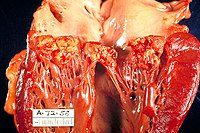
Photo from wikipedia
Abstract Background The incidence of infective endocarditis, a serious heart infection that can result from injection drug use, has increased in step with the opioid epidemic. Harm reduction services aimed… Click to show full abstract
Abstract Background The incidence of infective endocarditis, a serious heart infection that can result from injection drug use, has increased in step with the opioid epidemic. Harm reduction services aimed at decreasing infectious complications of injection drug use are limited in rural areas; however, it is unknown whether the burden of opioid use–associated infective endocarditis varies between rural and urban populations. Methods We used 2003–2016 National (Nationwide) Inpatient Sample data and joinpoint regression to compare trends in hospitalization for opioid use–associated infective endocarditis between rural and urban populations. Results Rates of US hospitalizations for opioid use–associated infective endocarditis increased from 0.28 to 3.86 per 100 000 rural residents, as compared with 1.26 to 3.49 for urban residents (overall difference in annual percent change P < .01). We observed 2 distinct trend periods, with a period of little change between 2003 and 2009/2010 (annual percent change, 0.0% rural vs –0.08% urban) followed by a large increase in hospitalization rates between 2009/2010 and 2016 (annual percent change, 0.35% rural vs 0.36% urban). Over the study period, opioid use–associated infective endocarditis hospitalizations shifted toward younger age groups for both rural and urban residents, and rural resident hospitalizations increasingly occurred at urban teaching hospitals. For both groups, Medicaid was the most common payer. Conclusions The increase in US hospitalizations for opioid use–associated infective endocarditis over the past decade supports the importance of public health efforts to reduce injection-related infections in both urban and rural areas. Future studies should examine factors affecting the higher increase in rate of these hospitalizations in rural areas.
Journal Title: Open Forum Infectious Diseases
Year Published: 2020
Link to full text (if available)
Share on Social Media: Sign Up to like & get
recommendations!